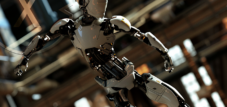Published on: May 28, 2025 / update from: May 28, 2025 - Author: Konrad Wolfenstein

Portable robotics and the development of the WIM Exoskeleton: Current progress in assistive technology-Image: creative image: xpert.digital
Ultra-light support: focus on Wirobotics's WIM system
Wim-Exoskeleton: Progress for healthy users and therapeutic applications
The development of portable robot systems is currently experiencing an important upswing, with innovative exoskeletons such as the WIM system of Wirobotics (not Werobotics, as originally assumed), set new standards in mobility support. The South Korean company Wirobotics has developed a system with its ultra-light hatchery robot Wim (WE Innovate Mobility) that enables impressive energy saving of up to 20% when walking on levels. Studies show that the system reduces muscle fatigue in the calf muscles by 79.5% and at the same time reduces oxygen consumption by 7.9%. These progress mark a turning point in the development of everyday assistant technologies that offer therapeutic advantages for both healthy users to increase performance and for people with mobility restrictions.
Suitable for:
- AI humanoid robots: Qinglong, Optimus Gen2 from Tesla, Kuavo from Leju Robotics and exoskeleton robots from ULS Robotics
Technological foundations of the portable robotics
Development and design principles
The modern, portable robotics are based on advanced biomechanical principles and material sciences that enable power -powerful support systems in a compact form. The WIM Exoskeleton exemplifies this development through its innovative design, which differs significantly from conventional, heavy exoskeletons. With a weight of only 1.6 kilograms and a design that is reminiscent of a belt bag, Wim breaks through the traditional limits of exoskeleton technology. The system uses a single engine that supports both legs at the same time via biomechanically optimized transmission elements, which ensures symmetrical power distribution.
The technical specifications of the WIM system show the progress in miniaturization: the device delivers a maximum torque of 6 Nm with a battery life of two hours of continuous use. These performance data are supplemented by intelligent sensor systems that record the user's gait analytics in real time and provide appropriate support. The compact design enables users of all body sizes, from average stature to over two meters tall, to carry the system securely by means of an adjustable Velcro fastener.
Artificial intelligence and adaptive systems
The integration of artificial intelligence into portable robot systems represents significant progress, which enables personalized support based on individual movement patterns. Wim uses advanced AI algorithms for gait analysis that evaluate parameters such as speed, agility and symmetry in real time. The accompanying mobile application calculates an individual “gang age” and creates tailor-made training plans to improve mobility and fitness. This data -controlled approach enables the system to continuously adapt to the needs of the user and to offer optimal support.
The AI-based coaching functionality of the WIM system collects long-term musculoskeletal data and increases the walking performance by adaptive algorithms. This technology allows the system to offer different operating modes: a support mode for facilitated movement, a resistance mode for strength training and special modes for mountain and rehabilitation applications. The system's ability to switch seamlessly between these modes demonstrates the versatility of modern portable robot systems.
Clinical validation and effectiveness studies
Biomechanical and physiological effects
The scientific validation of portable robot systems requires extensive biomechanical and physiological examinations that take into account both objective measurement parameters and subjective user experiences. Studies on the WIM Exoskeleton show significant improvements in several performance parameters: muscle fatigue in the calf muscles is reduced by 79.5%, while oxygen consumption decreases by 7.9% and the energy expenditure decreased by 7.4%. These results were determined in controlled treadmill studies and demonstrate the physiological effectiveness of the system when relieving the lower extremities.
The biomechanical advantages of the WIM system extend beyond the pure energy saving. The system reduces the energy costs when walking on level terrain by up to 20% and when wearing loads by 14%, which corresponds to a weight reduction of 12 kilograms. These performance increases are particularly noticeable in repeated movements, which contain forward movements, such as climbing stairs or pushing weights. The uniform power distribution on both hip joints ensures stability during exercise, even if this requires special attention in patients with ganglym metries, such as certain stroke patients.
Application in the medical field
The validation of exoskelettes in a medical context shows promising results for various patient groups and areas of application. A four -week usability study with seniors demonstrated a 78%improvement in physical functions, with the participants experiencing an increased walking speed, improved endurance and strengthened muscles of the lower extremities. These results underline the potential of portable robot systems in geriatrics and rehabilitation.
The use of exoskeletons in the surgical area shows further medical validation approaches. A study by the Clinic for Orthopedics, Trauma Surgery and Plastic Surgery of the Leipzig University Hospital examined the effects of Suitx Exoskeletons on Surgeons during and after operations. The results showed a significant pain reduction for neck, shoulder and back pain, improved comfort and increased endurance during long interventions. This study with 25 participants and 50 surgical interventions confirmed the feasibility and user acceptance, whereby 44% of the participants would use the exoskeleton frequently and 48% occasionally.
Market development and commercial implementation
Global market expansion
The commercial development of portable robot systems shows a dynamic market expansion, with innovative companies such as Wirobotics successfully carry out the transition from research prototypes to market tires. Wirobotics has already sold 500 units of the WIM system in South Korea and is now planning the market launch in the USA. This expansion is based on the success of the system, which at the Consumer Electronics Show (CES) 2024 Innovation Awards received in two categories: robotics and accessibility & aging tech.
The success of the WIM system on the Korean market, where it is sold for the equivalent of around $ 2,330, demonstrates the willingness of consumers to invest in portable robot technology. The planned US market launch aims at a broad target group ranging from active young people to seniors with mobility needs to patients in rehabilitation. This diversification of the target groups reflects the versatility of modern exoskeleton technology and shows the potential for broad social acceptance.
Technological differentiation and competitive advantages
The positioning of WIM in the market for portable robotics is based on significant technological differentiation features compared to conventional exoskelets. The significantly reduced weight of 1.6 kilograms compared to conventional systems of 25 kilograms or more represents a decisive competitive advantage. This weight reduction enables users to carry the system over longer periods without experiencing excessive stress.
The usability of the WIM system is evident in its intuitive design and simple handling. In contrast to heavy, complex exoskeletons, which require constant supervision by trained personnel, Wim can be created and operated independently by the users. The water and dust-resistant construction extends the possible uses to different environments and makes the system suitable for both indoor and outdoor use. This robustness, combined with the two -hour battery life and the interchangeable battery system, positions Wim as a practical solution for everyday life.
Suitable for:
- Currently the largest humanoid robotics study by Xpert.digital-Marktboom ahead: from robot prototypes to practice
Social effects and future prospects
Demographic change and assistive technologies
The increasing aging of society creates a growing need for assistive technologies that help older people to maintain their independence and mobility. Portable robot systems such as Wim address this demographic challenge by providing affordable and user -friendly solutions that reduce the energy expenditure when walking and increase endurance. The system's ability to offer different operating modes - from support for normal walking to resistance training - enables older users to actively maintain and improve their physical fitness.
However, the social effects extend beyond geriatrics. The concept of portable robotics aims at a “a person, a robot” era in which every single access to personalized robotic support has. This vision could revolutionize the way people with physical restrictions take part in social life and create new opportunities for professional and social integration. The integration of advanced AI technologies into these systems promises a continuous improvement of the quality of support and an adaptation to individual needs.
Human enhancement in focus: what the Bundeswehr study shows
The development and implementation of portable robot systems raises important ethical questions regarding the dependence on technology and the potential risks. The Bundeswehr study on human enhancement technologies indicates the need to carefully weigh both the advantages and the risks of performance-enhancing technologies. In the case of exoskelettes, there is a risk that improper use or excessive dependency can lead to musculoskeletal injuries, especially for users with existing ganglime metries.
The security aspects require continuous monitoring and improvement of the systems. Studies show that exoskeletons for squatting can increase the joint angles, and if excessive torque is exercised, undesirable consequences such as muscle stress, abnormal activity and injuries can occur. The development of robust security protocols and the training of the users are therefore essential for the safe implementation of these technologies. The two-hour battery life of the WIM system could be a restriction in professional applications and requires further technological improvements for use in labor-intensive environments.
Artificial intelligence and robotics: The future of personalized assistance
The development of portable robot systems such as Wim from Wirobotics marks significant progress in assistive technology and shows the potential for broad social transformation. The scientific validation through studies that demonstrate significant improvements in energy efficiency, muscle fatigue and physical performance underlines the therapeutic and performance -enhancing effectiveness of these technologies. The successful commercialization in South Korea and the planned expansion into international markets show that portable robot systems ripen from an experimental technology to practical, everyday solutions.
The future of the portable robotics will be significantly shaped by the further integration of artificial intelligence, the improvement of energy efficiency and development even easier and more user -friendly systems. While technological advances are promising, ethical considerations, security aspects and questions of accessibility must be carefully taken into account at the same time. The vision of a society in which every person has access to personalized robotic support could revolutionize the way we understand mobility, work and quality of life, but requires a balanced approach that brings technological innovation with human needs and social values.
Suitable for:
Your global marketing and business development partner
☑️ Our business language is English or German
☑️ NEW: Correspondence in your national language!
I would be happy to serve you and my team as a personal advisor.
You can contact me by filling out the contact form or simply call me on +49 89 89 674 804 (Munich) . My email address is: wolfenstein ∂ xpert.digital
I'm looking forward to our joint project.













